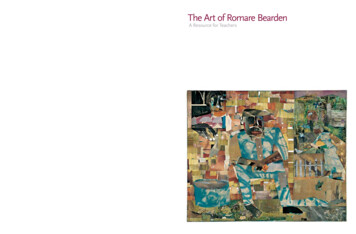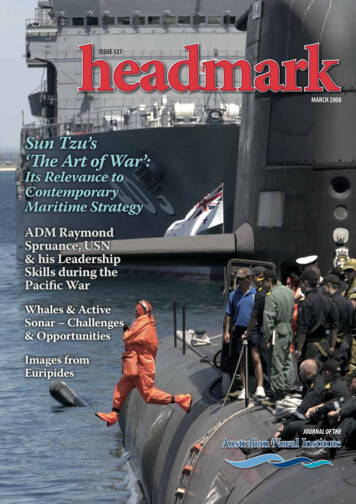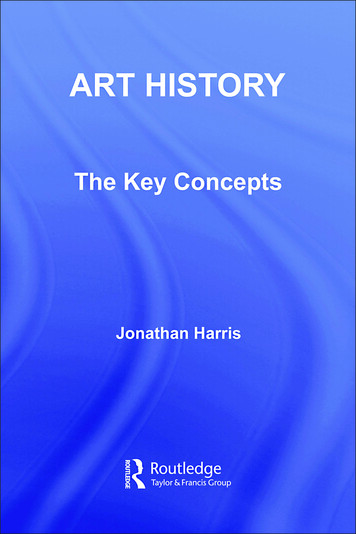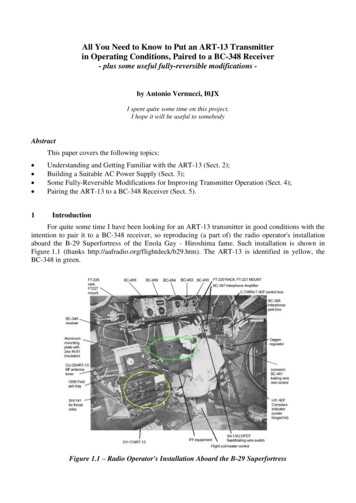
Transcription
In: Illuminations,edited by Hannah Arendt,translated by Harry Zohn, from the 1935 essayNew York: Schocken Books, 1969The Work of Artin the Age of Mechanical ReproductionWALTER BENJAMIN“Our fine arts were developed, their types and uses were established, in timesvery different from the present, by men whose power of action upon things wasinsignificant in comparison with ours. But the amazing growth of ourtechniques, the adaptability and precision they have attained, the ideas andhabits they are creating, make it a certainty that profound changes areimpending in the ancient craft of the Beautiful. In all the arts there is aphysical component which can no longer be considered or treated as it used tobe, which cannot remain unaffected by our modern knowledge and power. Forthe last twenty years neither matter nor space nor time has been what it wasfrom time immemorial. We must expect great innovations to transform theentire technique of the arts, thereby affecting artistic invention itself andperhaps even bringing about an amazing change in our very notion of art.”*Paul Valéry, PIÈCES SUR L’ART“Le Conquete de l’ubiquité,” Paris.PREFACEWhen Marx undertook his critique of the capitalistic mode of production,this mode was in its infancy. Marx directed his efforts in such a way as to givethem prognostic value. He went back to the basic conditions underlyingcapitalistic production and through his presentation showed what could beexpected of capitalism in the future. The result was that one could expect it notonly to exploit the proletariat with increasing intensity, but ultimately to createconditions which would make it possible to abolish capitalism itself.The transformation of the superstructure, which takes place far more slowlythan that of the substructure, has taken more than half a century to manifest inall areas of culture the change in the conditions of production. Only today can itbe indicated what form this has taken. Certain prognostic requirements shouldbe met by these statements. However, theses about the art of the proletariat afterits assumption of power or about the art of a classless society would have less*Quoted from Paul Valéry, Aesthetics, “The Conquest of Ubiquity,” translated by RalphManheim, p. 225. Pantheon Books, Bollingen Series, New York, 1964.
bearing on these demands than theses about the developmental tendencies of artunder present conditions of production. Their dialectic is no less noticeable inthe superstructure than in the economy. It would therefore be wrong tounderestimate the value of such theses as a weapon. They brush aside a numberof outmoded concepts, such as creativity and genius, eternal value andmystery—concepts whose uncontrolled (and at present almost uncontrollable)application would lead to a processing of data in the Fascist sense. Theconcepts which are introduced into the theory of art in what follows differ fromthe more familiar terms in that they are completely useless for the purposes ofFascism. They are, on the other hand, useful for the formulation ofrevolutionary demands in the politics of art.IIn principle a work of art has always been reproducible. Man-made artifactscould always be imitated by men. Replicas were made by pupils in practice oftheir craft, by masters for diffusing their works, and, finally, by third parties inthe pursuit of gain. Mechanical reproduction of a work of art, however,represents something new. Historically, it advanced intermittently and in leapsat long intervals, but with accelerated intensity. The Greeks knew only twoprocedures of technically reproducing works of art: founding and stamping.Bronzes, terra cottas, and coins were the only art works which they couldproduce in quantity. All others were unique and could not be mechanicallyreproduced. With the woodcut graphic art became mechanically reproduciblefor the first time, long before script became reproducible by print. Theenormous changes which printing, the mechanical reproduction of writing, hasbrought about in literature are a familiar story. However, within thephenomenon which we are here examining from the perspective of worldhistory, print is merely a special, though particularly important, case. Duringthe Middle Ages engraving and etching were added to the woodcut; at thebeginning of the nineteenth century lithography made its appearance.With lithography the technique of reproduction reached an essentially newstage. This much more direct process was distinguished by the tracing of thedesign on a stone rather than its incision on a block of wood or its etching on acopperplate and permitted graphic art for the first time to put its products on themarket, not only in large numbers as hitherto, but also in daily changing forms.Lithography enabled graphic art to illustrate everyday life, and it began to keeppace with printing. But only a few decades after its invention, lithography wassurpassed by photography. For the first time in the process of pictorialreproduction, photography freed the hand of the most important artisticfunctions which henceforth devolved only upon the eye looking into a lens.2
Since the eye perceives more swiftly than the hand can draw, the process ofpictorial reproduction was accelerated so enormously that it could keep pacewith speech. A film operator shooting a scene in the studio captures the imagesat the speed of an actor’s speech. Just as lithography virtually implied theillustrated newspaper, so did photography foreshadow the sound film. Thetechnical reproduction of sound was tackled at the end of the last century.These convergent endeavors made predictable a situation which Paul Valérypointed up in this sentence: “Just as water, gas, and electricity are brought intoour houses from far off to satisfy our needs in response to a minimal effort, sowe shall be supplied with visual or auditory images, which will appear anddisappear at a simple movement of the hand, hardly more than a sign.” (op. cit.,p. 226) Around 1900 technical reproduction had reached a standard that notonly permitted it to reproduce all transmitted works of art and thus to cause themost profound change in their impact upon the public; it also had captured aplace of its own among the artistic processes. For the study of this standardnothing is more revealing than the nature of the repercussions that these twodifferent manifestations—the reproduction of works of art and the art of thefilm—have had on art in its traditional form.IIEven the most perfect reproduction of a work of art is lacking in oneelement: its presence in time and space, its unique existence at the place whereit happens to be. This unique existence of the work of art determined the historyto which it was subject throughout the time of its existence. This includes thechanges which it may have suffered in physical condition over the years as wellas the various changes in its ownership.1 The traces of the first can be revealedonly by chemical or physical analyzes which it is impossible to perform on areproduction; changes of ownership are subject to a tradition which must betraced from the situation of the original.The presence of the original is the prerequisite to the concept ofauthenticity. Chemical analyzes of the patina of a bronze can help to establishthis, as does the proof that a given manuscript of the Middle Ages stems froman archive of the fifteenth century. The whole sphere of authenticity is outsidetechnical—and, of course, not only technical—reproducibility.2 Confrontedwith its manual reproduction, which was usually branded as a forgery, theoriginal preserved all its authority; not so vis à vis technical reproduction. Thereason is twofold. First, process reproduction is more independent of theoriginal than manual reproduction. For example, in photography, processreproduction can bring out those aspects of the original that are unattainable tothe naked eye yet accessible to the lens, which is adjustable and chooses its3
angle at will. And photographic reproduction, with the aid of certain processes,such as enlargement or slow motion, can capture images which escape naturalvision. Secondly, technical reproduction can put the copy of the original intosituations which would be out of reach for the original itself. Above all, itenables the original to meet the beholder halfway, be it in the form of aphotograph or a phonograph record. The cathedral leaves its locale to bereceived in the studio of a lover of art; the choral production, performed in anauditorium or in the open air, resounds in the drawing room.The situations into which the product of mechanical reproduction can bebrought may not touch the actual work of art, yet the quality of its presence isalways depreciated. This holds not only for the art work but also, for instance,for a landscape which passes in review before the spectator in a movie. In thecase of the art object, a most sensitive nucleus—namely, its authenticity—isinterfered with whereas no natural object is vulnerable on that score. Theauthenticity of a thing is the essence of all that is transmissible from itsbeginning, ranging from its substantive duration to its testimony to the historywhich it has experienced. Since the historical testimony rests on theauthenticity, the former, too, is jeopardized by reproduction when substantiveduration ceases to matter. And what is really jeopardized when the historicaltestimony is affected is the authority of the object.3One might subsume the eliminated element in the term “aura” and go on tosay: that which withers in the age of mechanical reproduction is the aura of thework of art. This is a symptomatic process whose significance points beyondthe realm of art. One might generalize by saying: the technique of reproductiondetaches the reproduced object from the domain of tradition. By making manyreproductions it substitutes a plurality of copies for a unique existence. And inpermitting the reproduction to meet the beholder or listener in his ownparticular situation, it reactivates the object reproduced. These two processeslead to a tremendous shattering of tradition which is the obverse of thecontemporary crisis and renewal of mankind. Both processes are intimatelyconnected with the contemporary mass movements. Their most powerful agentis the film. Its social significance, particularly in its most positive form, isinconceivable without its destructive, cathartic aspect, that is, the liquidation ofthe traditional value of the cultural heritage. This phenomenon is most palpablein the great historical films. It extends to ever new positions. In 1927 AbelGance exclaimed enthusiastically: “Shakespeare, Rembrandt, Beethoven willmake films . . . all legends, all mythologies and all myths, all founders ofreligion, and the very religions . . . await their exposed resurrection, and theheroes crowd each other at the gate.”**Abel Gance, “Le Temps de l’image est venu,” L’Art cinematographique, Vol 2, pp.94F, Paris, 1927.4
Presumably without intending it, he issued an invitation to a far-reachingliquidation.IIIDuring long periods of history, the mode of human sense perception changeswith humanity’s entire mode of existence. The manner in which human senseperception is organized, the medium in which it is accomplished, is determinednot only by nature but by historical circumstances as well. The fifth century,with its great shifts of population, saw the birth of the late Roman art industryand the Vienna Genesis, and there developed not only an art different from thatof antiquity but also a new kind of perception. The scholars of the Vienneseschool, Riegl and Wickhoff, who resisted the weight of classical tradition underwhich these later art forms had been buried, were the first to draw conclusionsfrom them concerning the organization of perception at the time. However farreaching their insight, these scholars limited themselves to showing thesignificant, formal hallmark which characterized perception in late Romantimes. They did not attempt—and, perhaps, saw no way—to show the socialtransformations expressed by these changes of perception. The conditions foran analogous insight are more favorable in the present. And if changes in themedium of contemporary perception can be comprehended as decay of the aura,it is possible to show its social causes.The concept of aura which was proposed above with reference to historicalobjects may usefully be illustrated with reference to the aura of natural ones.We define the aura of the latter as the unique phenomenon of a distance,however close it may be. If, while resting on a summer afternoon, you followwith your eyes a mountain range on the horizon or a branch which casts itsshadow over you, you experience the aura of those mountains, of that branch.This image makes it easy to comprehend the social bases of the contemporarydecay of the aura. It rests on two circumstances, both of which are related to theincreasing significance of the masses in contemporary life. Namely, the desireof contemporary masses to bring things ‘closer’ spatially and humanly, which isjust as ardent as their bent toward overcoming the uniqueness of every realityby accepting its reproduction.4 Every day the urge grows stronger to get hold ofan object at very close range by way of its likeness, its reproduction.Unmistakably, reproduction as offered by picture magazines and newsreelsdiffers from the image seen by the unarmed eye. Uniqueness and permanenceare as closely linked in the latter as are transitoriness and reproducibility in theformer. To pry an object from its shell, to destroy its aura, is the mark of aperception whose ‘sense of the universal equality of things’ has increased tosuch a degree that it extracts it even from a unique object by means of5
reproduction. Thus is manifested in the field of perception what in thetheoretical sphere is noticeable in the increasing importance of statistics. Theadjustment of reality to the masses and of the masses to reality is a process ofunlimited scope, as much for thinking as for perception.IVThe uniqueness of a work of art is inseparable from its being imbedded inthe fabric of tradition. This tradition itself is thoroughly alive and extremelychangeable. An ancient statue of Venus, for example, stood in a differenttraditional context with the Greeks, who made it an object of veneration, thanwith the clerics of the Middle Ages, who viewed it as an ominous idol. Both ofthem, however, were equally confronted with its uniqueness, that is, its aura.Originally the contextual integration of art in tradition found its expression inthe cult. We know that the earliest art works originated in the service of aritual—first the magical, then the religious kind. It is significant that theexistence of the work of art with reference to its aura is never entirely separatedfrom its ritual function.5 In other words, the unique value of the “authentic”work of art has its basis in ritual, the location of its original use value. Thisritualistic basis, however remote, is still recognizable as secularized ritual evenin the most profane forms of the cult of beauty.6 The secular cult of beauty,developed during the Renaissance and prevailing for three centuries, clearlyshowed that ritualistic basis in its decline and the first deep crisis which befellit. With the advent of the first truly revolutionary means of reproduction,photography, simultaneously with the rise of socialism, art sensed theapproaching crisis which has become evident a century later. At the time, artreacted with the doctrine of l’art pour l’art, that is, with a theology of art. Thisgave rise to what might be called a negative theology in the form of the idea of‘pure’ art, which not only denied any social function of art but also anycategorizing by subject matter. (In poetry, Mallarmé was the first to take thisposition.)An analysis of art in the age of mechanical reproduction must do justice tothese relationships, for they lead us to an all-important insight: for the first timein world history, mechanical reproduction emancipates the work of art from itsparasitical dependence on ritual. To an ever greater degree the work of artreproduced becomes the work of art designed for reproducibility.7 From aphotographic negative, for example, one can make any number of prints; to askfor the ‘authentic’ print makes no sense. But the instant the criterion ofauthenticity ceases to be applicable to artistic production, the total function ofart is reversed. Instead of being based on ritual, it begins to be based on anotherpractice—politics.6
VWorks of art are received and valued on different planes. Two polar typesstand out; with one, the accent is on the cult value; with the other, on theexhibition value of the work.8 Artistic production begins with ceremonialobjects destined to serve in a cult. One may assume that what mattered wastheir existence, not their being on view. The elk portrayed by the man of theStone Age on the walls of his cave was an instrument of magic. He did exposeit to his fellow men, but in the main it was meant for the spirits. Today the cultvalue would seem to demand that the work of art remain hidden. Certain statuesof gods are accessible only to the priest in the cella; certain Madonnas remaincovered nearly all year round; certain sculptures on medieval cathedrals areinvisible to the spectator on ground level. With the emancipation of the variousart practices from ritual go increasing opportunities for the exhibition of theirproducts. It is easier to exhibit a portrait bust that can be sent here and therethan to exhibit the statue of a divinity that has its fixed place in the interior of atemple. The same holds for the painting as against the mosaic or fresco thatpreceded it. And even though the public presentability of a mass originally mayhave been just as great as that of a symphony, the latter originated at themoment when its public presentability promised to surpass that of the mass.With the different methods of technical reproduction of a work of art, itsfitness for exhibition increased to such an extent that the quantitative shiftbetween its two poles turned into a qualitative transformation of its nature. Thisis comparable to the situation of the work of art in prehistoric times when, bythe absolute emphasis on its cult value, it was, first and foremost, an instrumentof magic. Only later did it come to be recognized as a work of art. In the sameway today, by the absolute emphasis on its exhibition value the work of artbecomes a creation with entirely new functions, among which the one we areconscious of, the artistic function, later may be recognized as incidental.9 Thismuch is certain: today photography and the film are the most serviceableexemplifications of this new function.VIIn photography, exhibition value begins to displace cult value all along theline. But cult value does not give way without resistance. It retires into anultimate retrenchment: the human countenance. It is no accident that the portraitwas the focal point of early photography. The cult of remembrance of lovedones, absent or dead, offers a last refuse for the cult value of the picture. For thelast time the aura emanates from the early photographs in the fleetingexpression of a human face. This is what constitutes their melancholy,7
incomparable beauty. But as man withdraws from the photographic image, theexhibition value for the first time shows its superiority to the ritual value. Tohave pinpointed this new stage constitutes the incomparable significance ofAtget, who, around 1900, took photographs of deserted Paris streets. It hasquite justly been said of him that he photographed them like scenes of crime.The scene of a crime, too, is deserted; it is photographed for the purpose ofestablishing evidence. With Atget, photographs become standard evidence forhistorical occurrences, and acquire a hidden political significance. Theydemand a specific kind of approach; free-floating contemplation is notappropriate to them. They stir the viewer; he feels challenged by them in a newway. At the same time picture magazines begin to put up signposts for him,right ones or wrong ones, no matter. For the first time, captions have becomeobligatory. And it is clear that they have an altogether different character thanthe title of a painting. The directives which the captions give to those looking atpictures in illustrated magazines soon become even more explicit and moreimperative in the film where the meaning of each single picture appears to beprescribed by the sequence of all preceding ones.VIIThe nineteenth-century dispute as to the artistic value of painting versusphotography today seems devious and confused. This does not diminish itsimportance, however; if anything, it underlines it. The dispute was in fact thesymptom of a historical transformation the universal impact of which was notrealized by either of the rivals. When the age of mechanical reproductionseparated art from its basis in cult, the semblance of its autonomy disappearedforever. The resulting change in the function of art transcended the perspectiveof the century; for a long time it even escaped that of the twentieth century,which experienced the development of the film. Earlier much futile thought hadbeen devoted to the question of whether photography is an art. The primaryquestion—whether the very invention of photography had not transformed theentire nature of art—was not raised. Soon the film theoreticians asked the sameill-considered question with regard to the film. But the difficulties whichphotography caused traditional aesthetics were mere child’s play as comparedto those raised by the film. Whence the insensitive and forced character of earlytheories of the film. Abel Gance, for instance, compares the film withhieroglyphs: “Here, by a remarkable regression, we have come back to the levelof expression of the Egyptians. . . . Pictorial language has not yet maturedbecause our eyes have not yet adjusted to it. There is as yet insufficient respect8
for, insufficient cult of, what it expresses.”* Or, in the words of Séverin-Mars:“What art has been granted a dream more poetical and more real at the sametime! Approached in this fashion the film might represent an incomparablemeans of expression. Only the most high-minded persons, in the most perfectand mysterious moments of their lives, should be allowed to enter itsambience.”† Alexandre Arnoux concludes his fantasy about the silent film withthe question: “Do not all the bold descriptions we have given amount to thedefinition of prayer?”‡ It is instructive to note how their desire to class the filmamong the “arts” forces these theoreticians to read ritual elements into it—witha striking lack of discretion. Yet when these speculations were published, filmslike L’Opinion Publique and The Gold Rush had already appeared. This,however, did not keep Abel Gance from adducing hieroglyphs for purposes ofcomparison, nor Séverin-Mars from speaking of the film as one might speak ofpaintings by Fra Angelico. Characteristically, even today ultrareactionaryauthors give the film a similar contextual significance—if not an outright sacredone, then at least a supernatural one. Commenting on Max Reinhardt’s filmversion of A Midsummer Night’s Dream, Werfel states that undoubtedly it wasthe sterile copying of the exterior world with its streets, interiors, railroadstations, restaurants, motorcars, and beaches which until now had obstructedthe elevation of the film to the realm of art. “The film has not yet realized itstrue meaning, its real possibilities . . . these consist in its unique faculty toexpress by natural means and with incomparable persuasiveness all that isfairylike, marvelous, supernatural.”*VIIIThe artistic performance of a stage actor is definitely presented to thepublic by the actor in person; that of the screen actor, however, is presented bya camera, with a twofold consequence. The camera that presents theperformance of the film actor to the public need not respect the performance asan integral whole. Guided by the cameraman, the camera continually changesits position with respect to the performance. The sequence of positional viewswhich the editor composes from the material supplied him constitutes thecompleted film. It comprises certain factors of movement which are in realitythose of the camera, not to mention special camera angles, close-ups, etc.*Abel Gance, op. cit., pp. 100-1.Séverin-Mars, quoted by Abel Gance, op. cit., p. 100.‡Alexandre Arnoux, Cinéma pris, 1929, p.28.*Franz Werfel, “Ein Sommernachtstraum, Ein Film von Shakespeare und Reinhardt,” NeuesWiener Journal, cited in Lu 15, November, 1935.†9
Hence, the performance of the actor is subjected to a series of optical tests. Thisis the first consequence of the fact that the actor’s performance is presented bymeans of a camera. Also, the film actor lacks the opportunity of the stage actorto adjust to the audience during his performance, since he does not present hisperformance to the audience in person. This permits the audience to take theposition of a critic, without experiencing any personal contact with the actor.The audience’s identification with the actor is really an identification with thecamera. Consequently the audience takes the position of the camera; itsapproach is that of testing.10 This is not the approach to which cult values maybe exposed.IXFor the film, what matters primarily is that the actor represents himself tothe public before the camera, rather than representing someone else. One of thefirst to sense the actor’s metamorphosis by this form of testing was Pirandello.Though his remarks on the subject in his novel Si Gira were limited to thenegative aspects of the question and to the silent film only, this hardly impairstheir validity. For in this respect, the sound film did not change anythingessential. What matters is that the part is acted not for an audience but for amechanical contrivance—in the case of the sound film, for two of them. “Thefilm actor,” wrote Pirandello, “feels as if in exile—exiled not only from thestage but also from himself. With a vague sense of discomfort he feelsinexplicable emptiness: his body loses its corporeality, it evaporates, it isdeprived of reality, life, voice, and the noises caused by his moving about, inorder to be changed into a mute image, flickering an instant on the screen, thenvanishing into silence . . . The projector will play with his shadow before thepublic, and he himself must be content to play before the camera.”* Thissituation might also be characterized as follows: for the first time—and this isthe effect of the film—man has to operate with his whole living person, yetforgoing its aura. For aura is tied to his presence; there can be no replica of it.The aura which, on the stage, emanates from Macbeth, cannot be separated forthe spectators from that of the actor. However, the singularity of the shot in thestudio is that the camera is substituted for the public. Consequently, the aurathat envelops the actor vanishes, and with it the aura of the figure he portrays.It is not surprising that it should be a dramatist such as Pirandello who, incharacterizing the film, inadvertently touches on the very crisis in which we seethe theatre. Any thorough study proves that there is indeed no greater contrast*Luigi Pirandello, Si Gira, quoted by Léon Pierre-Quint, “Signification de cinéma,” L’Artcinématographique, op. cit., pp. 14-15.10
than that of the stage play to a work of art that is completely subject to or, likethe film, founded in, mechanical reproduction. Experts have long recognizedthat in the film “the greatest effects are almost always obtained by ‘acting’ aslittle as possible. . . .” In 1932 Rudolf Arnheim saw “the latest trend. intreating the actor as a stage prop chosen for its characteristics and . . . insertedat the proper place.”11 With this idea something else is closely connected. Thestage actor identifies himself with the character of his role. The film actor veryoften is denied this opportunity. His creation is by no means all of a piece; it iscomposed of many separate performances. Besides certain fortuitousconsiderations, such as cost of studio, availability of fellow players, décor, etc.,there are elementary necessities of equipment that split the actor’s work into aseries of mountable episodes. In particular, lighting and its installation requirethe presentation of an event that, on the screen, unfolds as a rapid and unifiedscene, in a sequence of separate shootings which may take hours at the studio;not to mention more obvious montage. Thus a jump from the window can beshot in the studio as a jump from a scaffold, and the ensuing flight, if need be,can be shot weeks later when outdoor scenes are taken. Far more paradoxicalcases can easily be construed. Let us assume that an actor is supposed to bestartled by a knock at the door. If his reaction is not satisfactory, the directorcan resort to an expedient: when the actor happens to be at the studio again hehas a shot fired behind him without his being forewarned of it. The frightenedreaction can be shot now and be cut into the screen version. Nothing morestrikingly shows that art has left the realm of the “beautiful semblance” which,so far, had been taken to be the only sphere where art could thrive.XThe feeling of strangeness that overcomes the actor before the camera, asPirandello describes it, is basically of the same kind as the estrangement feltbefore one’s own image in the mirror. But now the reflected image has becomeseparable, transportable. And where is it transported? Before the public.12 Neverfor a moment does the screen actor cease to be conscious of this fact. Whilefacing the camera he knows that ultimately he will face the public, theconsumers who constitute the market. This market, where he offers not only hislabor but also hi
surpassed by photography. For the first time in the process of pictorial reproduction, photography freed the hand of the most important artistic functions which henceforth devolved only upon the eye looking into a lens. 3 Since the eye perc











